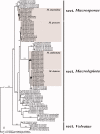Macrolepiota in Korea: New Records and a New Species
- PMID: 32010458
- PMCID: PMC6968693
- DOI: 10.1080/12298093.2019.1663122
Macrolepiota in Korea: New Records and a New Species
Abstract
The genus Macrolepiota (Agaricales, Basidiomycota) is easy to recognize at the genus level because of big, fleshy basidiocarps with squamules covering the pileus; a single or double annulus; and big, thick-walled basidiospores with a germ pore. However, morphological identification is often unreliable in Macrolepiota due to similar morphological features among species. Due to the uncertainty of previous morphological identification in the genus Macrolepiota, it is necessary to re-examine Korean Macrolepiota using molecular data. We re-examined 34 Macrolepiota specimens collected from 2012 to 2018 in Korea using a reverse taxonomic approach, whereby species identification was first done based on the internal transcribed spacer (ITS) region analysis, followed by morphological confirmation. We identified the presence of four species: M. detersa, M. mastoidea, M. procera, and M. umbonata sp. nov. Two species (M. detersa and M. mastoidea) were previously unrecorded from Korea and M. umbonata is a new species. Detailed descriptions of all four species and taxonomic key are provided in this study. Macrolepiota procera and M. umbonata are distributed through the country, but M. detersa and M. mastoidea are distributed only in limited areas. According to our results, the combination of ITS locus and morphology proved to be a robust approach to evaluate the taxonomic status of Macrolepiota species in Korea. Additional surveys are needed to verify the species diversity and clarify their geographic distribution.
Keywords: Agaricaceae; ITS; Macrolepiota umbonata; new taxa; reverse taxonomy.
© 2019 The Author(s). Published by Informa UK Limited, trading as Taylor & Francis Group on behalf of the Korean Society of Mycology.
Figures




Similar articles
-
Macrolepiota macilenta and M. pallida, two new species from North America.Fungal Syst Evol. 2024 Dec;14:139-152. doi: 10.3114/fuse.2024.14.09. Epub 2024 Apr 26. Fungal Syst Evol. 2024. PMID: 39830298 Free PMC article.
-
Phylogeny and taxonomy of Macrolepiota (Agaricaceae).Mycologia. 2003 May-Jun;95(3):442-56. Mycologia. 2003. PMID: 21156633
-
Sequestrate species of Agaricus and Macrolepiota from Australia: new species and combinations and their position in a calibrated phylogeny.Mycologia. 2012 Mar-Apr;104(2):496-520. doi: 10.3852/11-092. Epub 2011 Nov 8. Mycologia. 2012. PMID: 22067305
-
Nutritional and Therapeutic Potential of Stropharia rugosoannulata and Macrolepiota procera: From Composition to Health-Promoting Effect.J Fungi (Basel). 2025 Mar 27;11(4):259. doi: 10.3390/jof11040259. J Fungi (Basel). 2025. PMID: 40278080 Free PMC article. Review.
-
Taxonomic review of the genus Dirrhagofarsus in Korea (Coleoptera, Eucnemidae).Zookeys. 2018 Aug 13;(781):97-108. doi: 10.3897/zookeys.781.22335. eCollection 2018. Zookeys. 2018. PMID: 30271237 Free PMC article. Review.
Cited by
-
Macrolepiota macilenta and M. pallida, two new species from North America.Fungal Syst Evol. 2024 Dec;14:139-152. doi: 10.3114/fuse.2024.14.09. Epub 2024 Apr 26. Fungal Syst Evol. 2024. PMID: 39830298 Free PMC article.
-
Note of Five Unrecorded Mushrooms Including Three Rare Species on Mount Juwang in Korea.Mycobiology. 2020 May 13;48(3):157-168. doi: 10.1080/12298093.2020.1759348. eCollection 2020. Mycobiology. 2020. PMID: 37970564 Free PMC article.
References
-
- Singer R. The Agaricales in modern taxonomy. 4th ed Koenigstein: Koeltz Scientific Books; 1986.
-
- Kirk PM, Cannon PF, Minter DW, et al. . Dictionary of the fungi. 10th ed Wallingford: CABI; 2008.
-
- Ge ZW, Zhu LY, Vellinga EC. The genus Macrolepiota (Agaricaceae, Basidiomycota) in China. Fungal Divers. 2010;45(1):81–98.
-
- Lebel T, Syme A. Sequestrate species of Agaricus and Macrolepiota from Australia: new species and combinations and their position in a calibrated phylogeny. Mycologia. 2012;104(2):496–520. - PubMed
-
- Otieno DO. Macrolepiota aberdarense, a new edible mushroom from Kenya. Curr Res Environ Appl Mycol J Fungal Bio. 2018;8:247–253.
LinkOut - more resources
Full Text Sources
